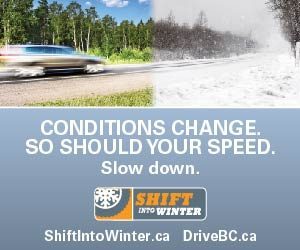Your top 5 Resources to get ready for driving this winter | TranBC
In BC, the incidence of work-related crashes increases during the winter driving season (Oct 1st to Mar 31st).
On October 2nd, 2017, the Winter Driving Safety Alliance launched the 2017 Shift into Winter Campaign— an annual road safety initiative focused on reducing the frequency and severity of winter weather-related vehicle crashes in BC. Together, we encourage drivers and workplaces to be prepared for the winter season.
5 actions to reduce the risk of a winter driving crash
- Prepare yourself and your vehicle for the winter season and conditions now. Do not wait until the snow, black ice, rain, fog, extended periods of darkness and colder temperatures hit. Whether you are driving a fleet or personal vehicle for work, ensure it is winter ready with a pre-season maintenance check-up. Ensure your vehicle is equipped with:
- a battery, brakes, light and fuses, cooling and heating systems, electrical and exhaust systems and belts and hoses, which have been found to be in good condition by a qualified person and meet manufacturer’s specifications.
- suitable first-aid supplies and a winter survival kit.
- a set of four matched winter tires. Winter tires in good condition with adequate tread depth are a legal requirement on BC highways during the winter driving season. While tires with the mud and snow symbol meet the minimum legal requirement, tires with the 3-peaked mountain and snowflake symbol offer the best traction on snow and ice, and when temperatures fall below 7°C.
- chains in good condition, that fit your tires and that you know how/ have the tools to put on, if you operate a commercial truck. Commercial vehicles in B.C. are legally required to carry chains from October 1 to March 31.
- Determine if driving for work is necessary. If possible, accomplish your work tasks via email, conference calls, online meetings, courier or public transit to eliminate the need to drive.
- Check road and weather conditions and determine whether it’s safe to drive. Check road conditions by using resources such as ca for highway driving or news or weather services before a trip. Don’t drive if conditions are unsafe, or worsening; cancel or re-schedule trips when necessary.
- Plan your trip. If driving is necessary, develop a trip plan including determining the safest route, alternate routes in case of closures or conditions, rest breaks and who and when you’ll be checking in with. Determine whether your vehicle is right for the trip; is it equipped for roads and weather conditions? Determine whether you are fit to drive; ensure you aren’t fatigued or on any medication, and that you have appropriate snacks and water available. Familiarize yourself with your vehicle’s safety features; adjust mirrors, seats, steering wheels, and head rests.
- Drive safely.
- Slow down. No matter how much driving experience you have, the way your vehicle will handle on snow, ice or rain can be unpredictable. The posted speed limit is the maximum speed allowed under ideal conditions. Drivers have a legal responsibility to drive according to the conditions, which often means driving below the posted speed limit. Reducing your speed will allow you more time to react to hazards such as black ice or pedestrians at intersections.
- Maintain a safe following distance. It takes longer to stop on a slippery road. Look ahead and keep plenty of distance between you and other cars — at least four seconds.
- Learn or be trained in winter driving skills such as how to brake safely and get out of a skid.
To find out more about winter driving safety, please visit the following websites. Review the resources and information and bookmark the sites into your web browser for easy access:
- Drivebc.ca – provides current road and travel conditions.
- Shiftintowinter.ca – information on how to prepare your vehicle, plan your trip and how to drive safely on winter roads.
- RoadsafetyatWork.ca – has comprehensive safety resources for employers, supervisors and occupational drivers.




